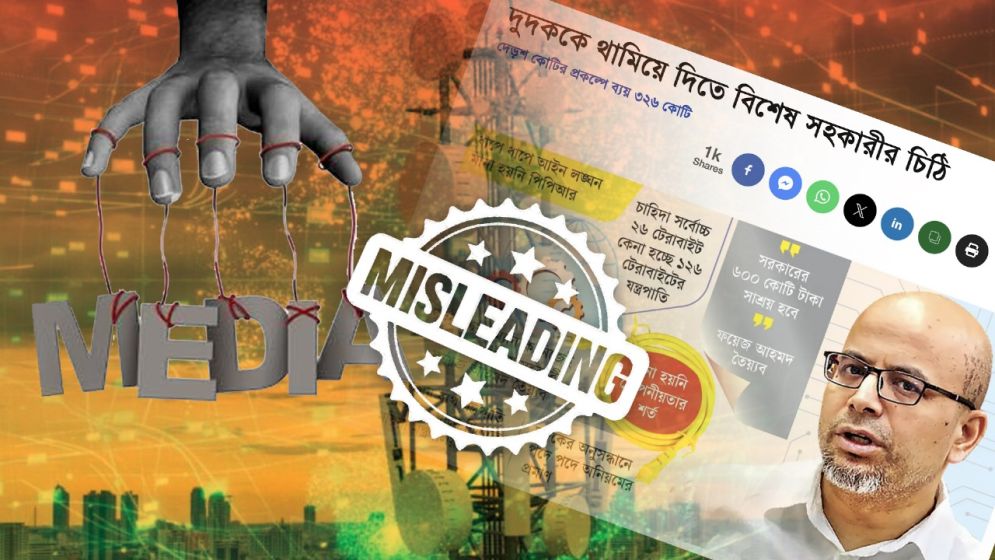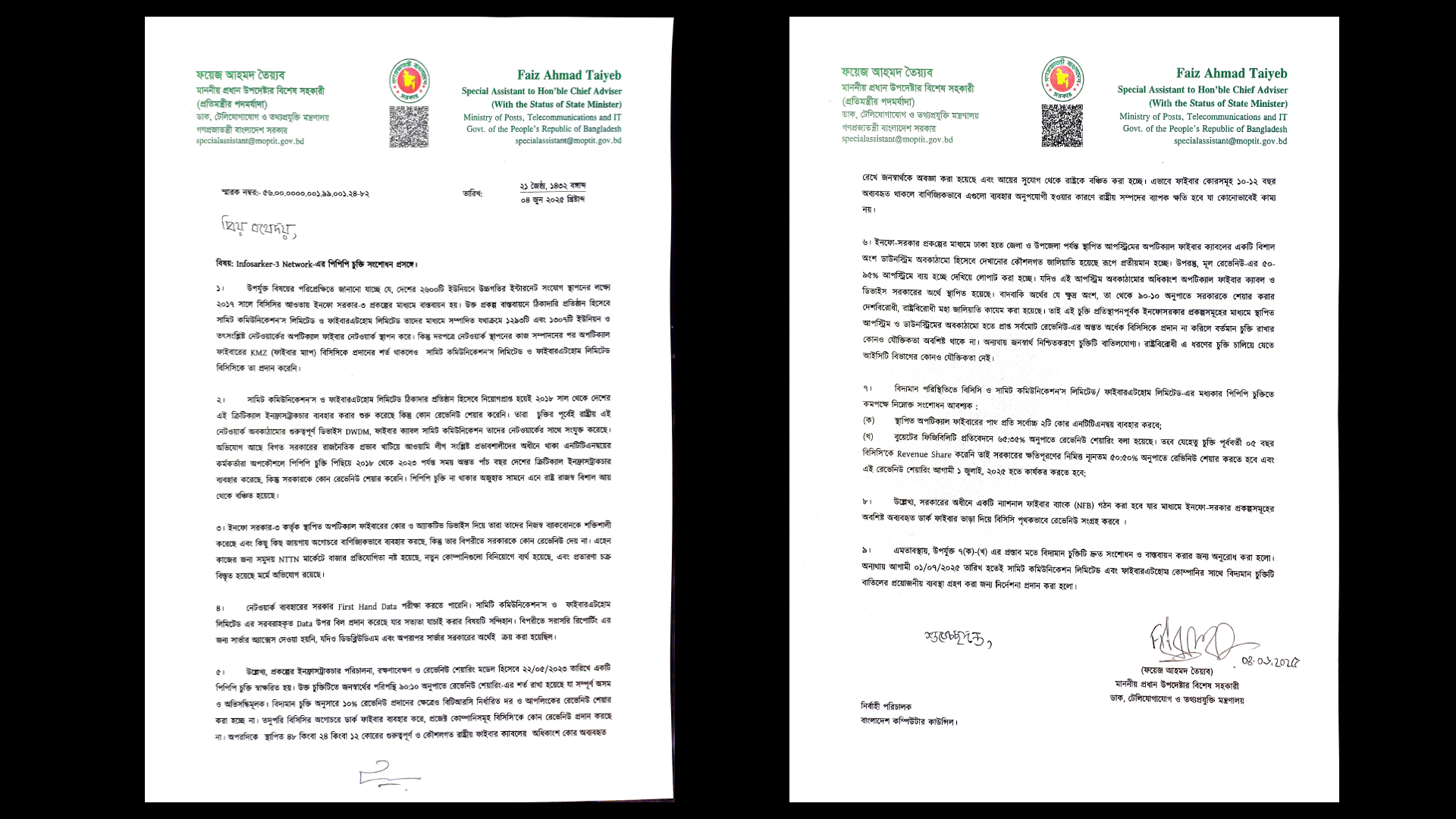Ticking all the boxes, missing the whole point: Kalbela’s skewed story on Faiz Taiyeb

On July 6, the vernacular daily Kalbela ran a front-page lead story titled “Special Assistant's Letter to Stop the ACC”, suggesting that Faiz Taiyeb Ahmed, Special Assistant to the Chief Adviser, had improperly intervened to halt an Anti-Corruption Commission (ACC) investigation into a contentious government project.
The report was based on a demi-official (DO) letter Faiz had sent to ACC Chairman Dr. Abdul Momin, in which he urged the commission to allow a project–initiated during Sheikh Hasina’s tenure–to proceed.
His recommendation was essentially grounded in a cost-benefit assessment of the situation, rather than an attempt to obstruct accountability.
However, Kalbela structured its report to imply that Faiz was directly interfering with the ACC’s work to push the project forward. The newspaper alleged that Faiz had applied “pressure” through formal correspondence written on official letterhead, and framed the communication as an abuse of power.
The report used highly charged language, including phrases such as: “despite concerns that this equipment, which hasn't yielded proper results in tests, will only be functional for 6-8 years and eventually be sold as scrap, those involved are unwilling to halt the flow of money,” and “investigation data suggests the government risks losing hundreds of crores of taka. A secret plundering scheme is underway under the guise of technology.”
Alongside the report, photos of Faiz’s DO letter began circulating widely on social media, amplified by journalists sharing it on their personal profiles.
Yet a closer reading of both the letter and the Kalbela article reveals that Faiz had, in fact, provided a set of logical and defensible reasons for continuing the project–mainly financial and strategic.
Nonetheless, the newspaper appeared to reverse the narrative through editorial choices, particularly in the headline and structure, crafting what seems to be a deliberate attempt to cast Faiz’s actions in a negative light.
The framing suggested misconduct, even though the content pointed to a rationale rooted in national interest.
It is true that Faiz’s DO letter exists and that it calls for reconsideration of a project flagged by the ACC, based on evolving cost assessments. It’s also accurate that the ACC had been following BUET’s earlier evaluation when initiating its inquiry.
Faiz’s letter however advocated reassessing that evaluation in light of updated data and national priorities.

Ticking all boxes, yet misleading
One thing has to be mentioned: within the landscape of Bangladeshi ICT journalism, Kalbela’s report does qualify as “newsworthy.”
After all, a State Minister–level official writing to the head of an independent watchdog agency to request continuation of a project under investigation is inherently of public interest.
However, the issue lies not in whether the report met the threshold of newsworthiness, but in how it was crafted.
In journalism, a story can meet all formal criteria and still function as a tool of misinformation through editorial framing and tone. Kalbela’s report is probably a textbook example of this–an article that, while technically grounded in fact, appears deliberately engineered to serve a misleading narrative.
Let’s first take a look at the project and its background.
Available documentation indicates that Bangladesh’s bandwidth market is dominated by two major private conglomerates, which collectively control around 70% of the total supply.
The remaining 30% is managed by the state-owned Bangladesh Telecommunications Company Limited (BTCL), which currently operates with a modest foundational capacity of 7 terabytes.
A project titled “Development of BTCL's Optical Fiber Transmission Network for 5G Readiness”, launched under the previous Awami League administration, has sparked significant controversy due to its scale, cost, and alleged political underpinnings.
At the heart of the dispute is the planned procurement of equipment with a total capacity of 126 terabytes–nearly five times greater than the 26.2 terabytes projected as sufficient by 2030, according to experts from the BUET.
This projection emerged from a comprehensive feasibility study BUET conducted in 2020, during the height of the COVID-19 pandemic when internet usage was at its peak. The study analyzed nationwide bandwidth consumption across all districts and sub-districts, including inputs from private operators.
Based on its findings, BUET recommended the use of 100G line cards to meet projected future demand.
However, these recommendations were reportedly disregarded by officials aligned with the Awami League, who moved forward with a significantly larger procurement plan.
This expanded infrastructure vision came with a steep cost–$30 million (BDT 326 crore)--double the 165 crore taka estimated by experts for the required infrastructure.
In communications with the Anti-Corruption Commission and in public statements, Faiz described the project as an effort to strengthen national control over critical digital infrastructure.
-686a1d014282b.jpg)
The rationale behind the letter
Faiz, defending the initiative, argued that halting the project would lead to substantial financial losses, citing the issuance of an irrevocable Letter of Credit (LC) worth 290 crore taka that had been approved prior to his tenure.
If canceled, those funds would be unrecoverable. He further warned that re-tendering the project could drive costs up by an additional 600 crore taka–potentially resulting in total losses nearing 900 crore taka, a burden he claimed the country could not afford to bear.
Furthermore, halting the project, according to Faiz, would only serve to entrench the dominance of two private companies–Summit Communications Ltd and Fibar@home–who, he believes, benefited from preferential treatment during Prime Minister Hasina’s administration.
These two firms, which currently control a major share of the bandwidth market, are reportedly resistant to BTCL’s expansion efforts and are actively working to undermine them. Faiz warns that their overwhelming market presence amounts to a near-monopoly over Bangladesh’s digital infrastructure.
From his perspective, allowing BTCL to collapse would effectively hand over control of the nation’s internet backbone to private entities, some with potential foreign ties.
While the procurement of 126 terabytes may seem excessive in the short term, he frames it as a strategic safeguard–essential to national security, future capacity planning, and preventing total market capture by private players.
What critics label as overinvestment, he argues, is in fact the cost of securing Bangladesh’s long-term digital sovereignty.
Faiz, himself a graduate of BUET, also challenges the validity of the BUET feasibility report, which forms the basis for lower demand estimates. He claims the report is outdated and overly conservative, noting that current national bandwidth usage has already reached nearly 35 terabytes.
With internet demand growing at an estimated 50% annually, Faiz warns that settling for a smaller, more limited system could lead to premature obsolescence–potentially before 2030.
In his view, the 126-terabyte infrastructure is not an overreach rather a forward-looking investment designed to future-proof the country’s digital backbone. He maintains that continuing the project, despite its high upfront cost, reflects both fiscal prudence and strategic foresight.
By emphasizing the long-term savings–avoiding piecemeal upgrades, vendor lock-ins, and recurring expansion costs–Faiz’s letter essentially argued that continuing the project would be in the country’s best interest, potentially saving the government around 600 crore taka.
However, Kalbela appeared to have deliberately framed the report in a way that presented a distorted picture to the public.
—---

